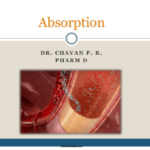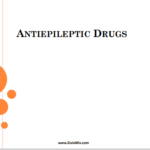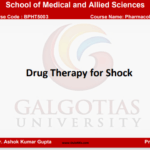A Presentation on:
CONCEPTS,EVENTS AND
BIOLOGICAL PROCESSES
INVOLVED IN DRUG
TARGETTING Presented by-
SWASTIK JYOTI PAL
M.Pharm 2nd sem
Roll.no-01
Bengal School of Technology
Hooghly
WHY DRUG TARGETTING IS
NEEDED?
5.Reaching difficult organs
1.Pharmaceutical factors * brain, retina, tumours
• Drug instability in conventional dosage form 6.Intracellular drug delivery
• Low Solubility * oligonucleotides,
2.Biopharmaceutical factors intracellular proteins, genes
• Low absorption 7.Prolonging drug response
• High-membrane bounding * drug retention and release
• Biological instability are prolonged
3.Pharmacokinetic / Pharmacodynamic (e.g. retina)
factors
• Short half-life
• Large volume of distribution
• Low specificity
4.Clinical factors
• Low therapeutic index.
DRUG TARGETTING-concepts
Drug Targetting is selective and effective localization of the
pharmacologically-active moiety at preidentified target(s) in
therapeutic concentration, while restricting its access to non-
target(s) normal cellular linings, thus minimizing toxic effects and
maximizing the therapeutic index.
The drug may thus be delivered:
1. To the capillary bed of the active sites,
2. To the specific type of cell (or) even an intracellular region.
Ex- tumour cells but not to normal cells,
3. To a specific organ (or) tissues by complexing with the carrier
that recognizes the target
The controlled and localized delivery of drugs and the
specific binding with the target receptors are specific
features of drug targeting.
This leads to high drug concentration with higher
efficacy.
The lower concentration at nontarget tissue lowers the
incidence of adverse effects and also decrease the dose.
Chemotherapy of cancer is the most glaring example
where drug targeting is highly desirable.
PROPERTIES OF IDEAL TARGETTTED DRUG DELIVERY
SYSTEM-
1. Nontoxic, biocompatible and physicochemical stable in vivo and
invitro.
2. Restrict drug distribution to target cells or tissue or organ or
should have uniform capillary distribution.
3. Controllable and predictable rate of drug release.
4. Minimal drug leakage during transit.
5. Carrier used must be biodegradable or readily eliminated from
the body without any problem.
6. Its preparation should be easy or reasonably simple, reproductive
and cost effective.
TARGETED DRUG DELIVERY SYSTEM:
DRUG NANOCRYSTALS
LIPID BASED SYSTEMS
* micelles
* liposomes
* hexosomesand cubosomes
* solid lipid nanoparticles, nanoemulsions
* lipid complexes
POLYMER BASED SYSTEMS
* polymeric nanoparticles
* polymeric micelles
* polymeric conjugates
* dendrimers
* polymersomes
* polymer complexes
INORGANIC MATERIALS
* silicon, silica
* metals
* carbon nanotubes
MICROVESICLES
ANTIBODIES
COMPONENTS OF DRUG TARGETTING:
• Specific organ or a cell or group
Target of cells,which in chronic or acute
condition needtreatment.
• Special molecules or system
Carrier essentially required for effective
transportation of loaded drug up
to the pre selected sites
Strategies of
drug
targeting
Chemical Carrier
modification mediated
Chemical
Prodrug Active Passive Inverse Physical Dual
delivery
approach targeting targeting targeting targeting targeting
system
First order Second order Third order
Cellular uptake
and processing
Transport across
epithelial barrier
Extravasation
Lymphatic
uptake
Biological process
involved in drug targeting
CELLULAR UPTAKE AND PROCESSING-
Following administration low molar mass drugs can enter into or pass through various cells by
simple diffusion process.
Targeted drug delivery usually have macro molecular assemblies hence cannot enter by such simple
process. Hence take up by a process called ENDOCYTOSIS
Steps involved :
Internalization of the plasma membrane
Concomitant with engulfment of extracellular material
Compared with phagocytosis pinocytosis is a universal phenomenon in all the cells pinocytosis
does not require any external stimulus
Pinocytosis is divided into two types:
Fluid phases pinocytosis
Adsorptive pinocytosis
Compared with phagocytosis fluid phase pinocytic capture of molecules is relatively slower being
directly proportional to the concentration and size dependant
TRANSPORT ACROSS EPITHELIAL BARRIER-
The oral buccal nasal vaginal and rectal cavities are internally lined with one or
more layers of epithelial cells
Depending on the position and function in the body epithelial cells can be varied
forms
Three layer physiology:
Epithelial, Lamia propria ,Basal lamina
Low molar mass drugs cross the above by passive difussion carrier mediated
systems and selective and non-selective endocytosis
The polar materials diffuse through tight junctions of epithelial cells
Passive transport is usually higher in damaged mucosa where as active
transportdepends on structural integrity of epithelial cells
Positively charged particles showed increased uptake than negatively charged
counterparts.
Absoption of drugs from buccal via transcellular and paracellular later being
dominant.
EXTRAVASATION-
Many diseases result from the dysfunction of cells located outside the cardiovascular system thus for a
drug to exert its therapeutic effects it must exit from the central circulation this process of trans vascular
exchange is called Extravasation which is governed by blood capillary walls.
Factors that control permeability of capillaries
• Structure of the capillary wall
• Pathological condition
• Rate of blood and lymph supply
• Physicochemical factors of drug
The structure of the blood capillary varies in different organs tissues.It consists of a single layer of
endothelia cells joined together by intercellular juctions.
The endothelium of brain is the strongest of all endothelia formed by continuous nonfenestrated
endothelial cells which show no pinocytic activity
Soluble macromolecules permeate the endothelial barrier more readily than particulate macromolecules
the rate of movement of fluid across the endothelium appears to be directly related to the difference
between the hydrostatic and osmotic forces.
LYMPHATIC UPTAKE-
Following extravasation drug molecules can either reabsorb into the blood stream
directly or enter into the lymphatic system and return with the lymph to the blood
circulation
Also drugs administered by subcutaneous intracellular transdermal peritoneal routes
can reach the systemic circulation by lymphatic system
Factors know to influence the clearance of drugs from interstitial sites
1. Route of administration
2. Size and surface characteristics of particles
3. Formulation medium
4. The composition and
5. pH of the interstitial fluid and
6. Disease within the interstitium
The direct delivery of drugs into lymphatics has been proposed as a potential
approach to kill malignant lymphoid cells located in lymph nodes.
CONCLUSION-
Targeted drug delivery essentially implies for selective and effective
localization of the pharmacologically-active moiety at preidentified
target(s) in therapeutic concentration,
Various strategies such as active targeting, passive targeting etc. can
be applied to achieve efficient drug targeting.
The targeted delivery is of great importance in cancer chemotherapy
which always demands for reduction in adverse effect.
REFERENCES-
1. Muller, R; Keck, C (2004). “Challenges and solutions for the delivery
of biotech drugs – a review of drug nanocrystal technology and lipid
nanoparticles”. Journal of Biotechnology 113 (1–3): 151–170.
doi:10.1016/j.jbiotec.2004.06.007
2. Introduction to novel drug delivery systems(2nd edition)-N.K Jain
,Vallabh prakashan , New Delhi,Pg-16-34
3. https://www.slideshare.net/vishnudatta/targeted-drug-delivery-systems
4. http://www.authorstream.com/Presentation/atitpandey-1737739-
biological-process-events-drug-targeting/
5. https://courses.helsinki.fi/sites/default/files/course-
material/4523810/BJK%20nano%20241017.pdf
THANK YOU!










